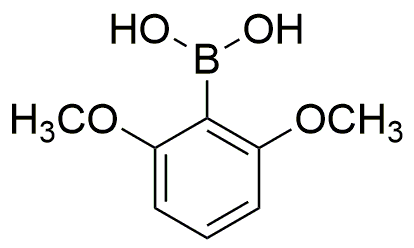2,6-Dimethoxyphenylboronic acid is widely utilized in research focused on:
- Organic Synthesis: This compound serves as a key reagent in Suzuki-Miyaura cross-coupling reactions, allowing chemists to create complex organic molecules efficiently. Its ability to form stable boronate esters makes it invaluable in developing pharmaceuticals and agrochemicals.
- Bioconjugation: It is employed in bioconjugation techniques, facilitating the attachment of biomolecules to surfaces or other molecules. This application is crucial in the development of targeted drug delivery systems and diagnostic tools.
- Sensor Development: The compound is used in creating sensors for detecting various analytes, including glucose. Its sensitivity and selectivity make it suitable for applications in medical diagnostics and environmental monitoring.
- Material Science: In the field of material science, it plays a role in the development of polymeric materials with enhanced properties, such as improved conductivity or mechanical strength, which are essential for electronics and packaging industries.
- Research in Medicinal Chemistry: It is utilized in the design and synthesis of new drug candidates, particularly in targeting specific biological pathways. Its unique properties allow for modifications that can enhance the efficacy and reduce side effects of therapeutic agents.
General Information
Properties
Safety and Regulations
Applications
2,6-Dimethoxyphenylboronic acid is widely utilized in research focused on:
- Organic Synthesis: This compound serves as a key reagent in Suzuki-Miyaura cross-coupling reactions, allowing chemists to create complex organic molecules efficiently. Its ability to form stable boronate esters makes it invaluable in developing pharmaceuticals and agrochemicals.
- Bioconjugation: It is employed in bioconjugation techniques, facilitating the attachment of biomolecules to surfaces or other molecules. This application is crucial in the development of targeted drug delivery systems and diagnostic tools.
- Sensor Development: The compound is used in creating sensors for detecting various analytes, including glucose. Its sensitivity and selectivity make it suitable for applications in medical diagnostics and environmental monitoring.
- Material Science: In the field of material science, it plays a role in the development of polymeric materials with enhanced properties, such as improved conductivity or mechanical strength, which are essential for electronics and packaging industries.
- Research in Medicinal Chemistry: It is utilized in the design and synthesis of new drug candidates, particularly in targeting specific biological pathways. Its unique properties allow for modifications that can enhance the efficacy and reduce side effects of therapeutic agents.
Documents
Safety Data Sheets (SDS)
The SDS provides comprehensive safety information on handling, storage, and disposal of the product.
Product Specification (PS)
The PS provides a comprehensive breakdown of the product’s properties, including chemical composition, physical state, purity, and storage requirements. It also details acceptable quality ranges and the product's intended applications.
Certificates of Analysis (COA)
Search for Certificates of Analysis (COA) by entering the products Lot Number. Lot and Batch Numbers can be found on a product’s label following the words ‘Lot’ or ‘Batch’.
*Catalog Number
*Lot Number
Certificates Of Origin (COO)
This COO confirms the country where the product was manufactured, and also details the materials and components used in it and whether it is derived from natural, synthetic, or other specific sources. This certificate may be required for customs, trade, and regulatory compliance.
*Catalog Number
*Lot Number
Safety Data Sheets (SDS)
The SDS provides comprehensive safety information on handling, storage, and disposal of the product.
DownloadProduct Specification (PS)
The PS provides a comprehensive breakdown of the product’s properties, including chemical composition, physical state, purity, and storage requirements. It also details acceptable quality ranges and the product's intended applications.
DownloadCertificates of Analysis (COA)
Search for Certificates of Analysis (COA) by entering the products Lot Number. Lot and Batch Numbers can be found on a product’s label following the words ‘Lot’ or ‘Batch’.
*Catalog Number
*Lot Number
Certificates Of Origin (COO)
This COO confirms the country where the product was manufactured, and also details the materials and components used in it and whether it is derived from natural, synthetic, or other specific sources. This certificate may be required for customs, trade, and regulatory compliance.


